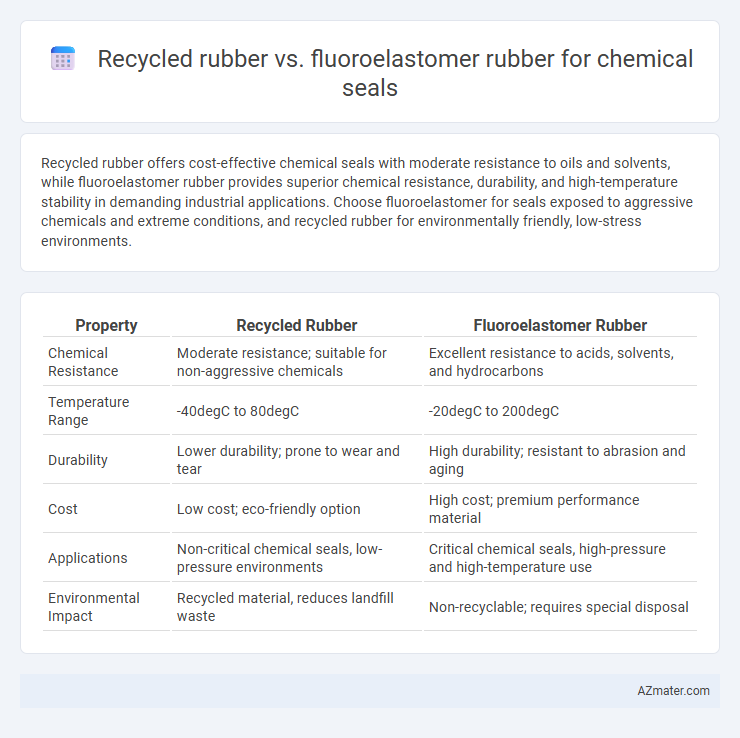Recycled rubber offers cost-effective chemical seals with moderate resistance to oils and solvents, while fluoroelastomer rubber provides superior chemical resistance, durability, and high-temperature stability in demanding industrial applications. Choose fluoroelastomer for seals exposed to aggressive chemicals and extreme conditions, and recycled rubber for environmentally friendly, low-stress environments.
Table of Comparison
| Property | Recycled Rubber | Fluoroelastomer Rubber |
|---|---|---|
| Chemical Resistance | Moderate resistance; suitable for non-aggressive chemicals | Excellent resistance to acids, solvents, and hydrocarbons |
| Temperature Range | -40degC to 80degC | -20degC to 200degC |
| Durability | Lower durability; prone to wear and tear | High durability; resistant to abrasion and aging |
| Cost | Low cost; eco-friendly option | High cost; premium performance material |
| Applications | Non-critical chemical seals, low-pressure environments | Critical chemical seals, high-pressure and high-temperature use |
| Environmental Impact | Recycled material, reduces landfill waste | Non-recyclable; requires special disposal |
Introduction to Chemical Seals
Chemical seals rely on high-performance materials to withstand aggressive chemicals and extreme conditions, with recycled rubber and fluoroelastomer rubber offering distinct advantages. Recycled rubber provides cost-effective elasticity and moderate chemical resistance, ideal for less demanding applications and sustainable solutions. Fluoroelastomer rubber delivers exceptional chemical resistance, thermal stability, and durability, making it the preferred choice for sealing in harsh chemical environments.
Overview of Recycled Rubber
Recycled rubber, derived from processed scrap tires and industrial rubber waste, offers an eco-friendly and cost-effective option for chemical seals, providing good flexibility and moderate chemical resistance. Its porous structure often limits its use in highly aggressive chemical environments compared to fluoroelastomer rubber, which excels in resisting acids, bases, and solvents. Despite this, recycled rubber remains popular in applications where sustainability and budget are prioritized over extreme chemical durability.
Understanding Fluoroelastomer Rubber
Fluoroelastomer rubber offers exceptional chemical resistance, withstanding aggressive solvents, acids, and hydrocarbons, making it a preferred choice for chemical seals in harsh environments. Unlike recycled rubber, fluoroelastomer maintains its sealing integrity under extreme temperatures (-26degC to 204degC) and resists swelling, cracking, and degradation. Its molecular structure featuring fluorine atoms provides superior impermeability and durability, critical for maintaining reliable seals in chemical processing applications.
Chemical Resistance: Recycled vs Fluoroelastomer
Fluoroelastomer rubber offers superior chemical resistance, maintaining integrity against aggressive chemicals, fuels, and solvents, making it ideal for demanding chemical seal applications. Recycled rubber, while cost-effective and environmentally friendly, generally exhibits lower resistance to harsh chemicals and may degrade faster under prolonged exposure. Choosing fluoroelastomer seals ensures enhanced durability and reliability in chemically aggressive environments compared to recycled rubber alternatives.
Temperature Stability Comparison
Recycled rubber exhibits moderate temperature stability, typically withstanding continuous exposure up to 80-100degC, which limits its suitability for high-temperature chemical seal applications. Fluoroelastomer rubber, such as Viton(r), offers superior temperature resistance, maintaining integrity and chemical resistance in extreme environments from -40degC up to 200-250degC. The enhanced thermal stability of fluoroelastomer rubber makes it the preferred choice for seals in aggressive chemical processes requiring reliable performance under high-temperature conditions.
Durability and Lifespan Analysis
Recycled rubber exhibits moderate chemical resistance but generally falls short in durability and lifespan compared to fluoroelastomer rubber, which offers superior resistance to harsh chemicals, high temperatures, and aggressive solvents. Fluoroelastomer seals demonstrate extended service life in chemical processing environments, maintaining integrity under extreme conditions due to their molecular structure and low permeability. The enhanced resilience of fluoroelastomer rubber significantly reduces maintenance frequency and replacement costs, making it a preferred choice for long-term chemical sealing applications.
Environmental Impact and Sustainability
Recycled rubber significantly reduces waste and lowers carbon footprints by repurposing existing materials, making it a sustainable option for chemical seals. Fluoroelastomer rubber, while highly resistant to chemicals and temperature extremes, typically involves energy-intensive production and contains fluorinated compounds that pose environmental challenges during disposal. Choosing recycled rubber aligns better with circular economy principles, minimizing environmental impact while maintaining adequate chemical resistance for many sealing applications.
Cost and Availability Factors
Recycled rubber offers significant cost advantages due to lower raw material expenses and widespread availability from post-consumer sources, making it a budget-friendly option for chemical seals. Fluoroelastomer rubber, while substantially more expensive, provides superior chemical resistance and durability, but its limited production and higher raw material costs impact availability. For applications prioritizing cost-efficiency and standard chemical exposure, recycled rubber is preferable, whereas critical environments demanding high-performance seals justify the investment in fluoroelastomer materials.
Application Suitability in Chemical Industries
Fluoroelastomer rubber offers superior chemical resistance, making it highly suitable for seals exposed to aggressive solvents, acids, and high-temperature environments commonly found in chemical processing industries. Recycled rubber, while cost-effective and environmentally friendly, generally lacks the chemical stability and durability required for such demanding applications, limiting its use to less harsh conditions. Selecting fluoroelastomer seals ensures enhanced longevity and safety in chemical plants where exposure to reactive substances is frequent.
Conclusion: Choosing the Right Rubber for Chemical Seals
Recycled rubber offers cost-effective and environmentally friendly benefits but may lack the chemical resistance and durability required for aggressive chemical seal applications. Fluoroelastomer rubber, known for its exceptional resistance to oils, solvents, and high temperatures, provides superior performance and longevity in harsh chemical environments. Selecting the right rubber for chemical seals depends on balancing budget constraints with the need for reliability, making fluoroelastomer the preferred choice for critical and demanding chemical sealing tasks.

Infographic: Recycled rubber vs Fluoroelastomer rubber for Chemical seal
 azmater.com
azmater.com